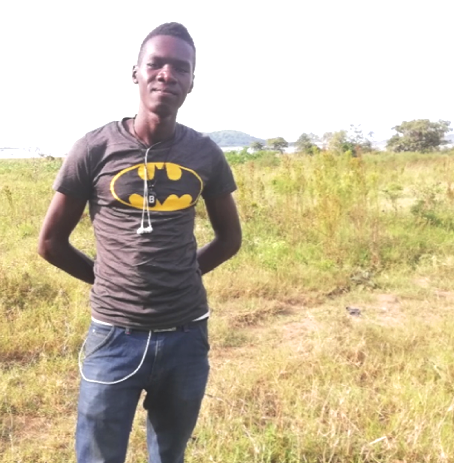FARMER STORIES
Voices from Farmer’s Experiences in the Innovations in Dry Season Horticulture
“Participating in the irrigation group has empower my family financially because there is continuous income. I’m confident participating in the group. My life is changed because I’m able to speak in public and able to look for market by myself”
— Anyango Judith
Bagume Topista
Site: Kyekidde, Jinja District, Uganda
Photo-Voice
Farmers’ take their own photos to explain their work in irrigation
Bagume Topista is a 41 year old vegetable farmer in the site in Kyekkide, located in Jinja District, Uganda. In addition to growing vegetables, she also runs a small hairdressing and grocery business. She is married with 6 children, with a simple goal in life, to increase her family’s income.
Topista does all her farming by herself, and labor for irrigating with watering cans has always been one of her major challenges. Since participating in the Innovations in Dry Season Horticulture project, she thinks that it is now possible to grow more irrigated crops, by using the new innovations her and her group help develop. She is now a leader in a women’s subgroup in her site, and can see that it’s possible to increase their irrigable land through using easier methods for irrigating such as a rain gun that she saw in an exchange visit with the project group in Busia, and a local adaptation farmers know as Adhoola (a drag-hose system).
Bagume, has also found new friends by being in the project and she said that this provide a support group for other issues in life.
“When the rain is too much the yields are poor, but when it rains reasonable the yields are ok, because its rains and shines. However, with the irrigation project when it’s hot the crops are watered using watering cans, and we can get more yields, supporting when there isn’t rain. I had also gotten new skills and friends”.
Patrick Chemonges
Site: Atari, Kween District, Uganda
Photo-Voice
Farmers’ take their own photos to explain their work in irrigation
Chemonges Patrick is a farmer from in Atari, Kween District, Ugnanda with 6 years of experience in growing vegetables and other crops. He is 32 years old, and started farming after abandoning charcoal burning as a business. He is married and has 6 children, some of whom join him in doing farming. His goals in farming are to get increased yields and eliminate poverty in his life.
Together with his family, Chemonges decides what to plant depending on the season and projected demand of vegetables. He makes a work plan for the rainy season when he grows a variety of crops, and in the dry season he grows vegetables using irrigation. For 3 years that he has participated in the Innovation in Dry Season Horticulture project, and can see that an increase in the quantity of vegetables he grows. Because of this, he has opened up more land for irrigation. Through all of this he said that he has benefited from all year availability of vegetables, a better balanced diet for his family, increased income, and less difficulty raising school fees for children.
“I used to play cards a lot, being idle at the trading center, now his time is productive. I spend most of my time attending to vegetables.”
Aidat Wolayo
Site: Lwasso, mbale District, Uganda
Photo-Voice
Farmers’ take their own photos to explain their work in irrigation
Aidat Wolayo has been a famer for 40 years, in Lwasso, Mbale District, Uganda. She is 54 years old and is a widow mother of 8 children. When she got married, farming became her source of income, and has taken advantage of many trainings and projects to become one of the leading farmers in her area. She farms mostly alone, but when children are at home from school, they help her.
Wolayo told us that she decides what to plant depending on the season and how she expects the market demand of vegetables to be. In the rainy season she grows a variety of crops but mainly grows vegetables in the dry season using irrigation. She has been irrigating for roughly 10 years. The traditional method she used to use for irrigation was by using a washbasin to throw water on the nearby plot from a small canal. Since participating in the Horticulture Irrigation project she has helped set up a gravity flow system that diverts water into a pressurized pipe, which she sprays by hand on her plot using a drag hose.
Aidat wants in the future to increase her yields and eliminate poverty in her household and community.
“Now I enjoy my work, because there is less drudgery, takes less time to do the irrigation. It is easier to use new system. I’m receiving exposure as communities around come to seek for knowledge and I also get the opportunity to participate in exchange visits.”
Boaz Otieno
Site: Kabos, serere District, Uganda
Photo-Voice
Farmers’ take their own photos to explain their work in irrigation
Otieno Boaz is one of the young farmers in the project and is the coordinator site of Kabos. He is 23 years old, and has been farming for around 5 years. Originally, he was involved in family farming activities but has now started managing plots of his own.
Since 4 years ago that he is in the irrigation project, he considers that irrigating helps to increase his crops’ performance, however he thinks it’s expensive in terms of fuel purchase and repairs to the system. When he started irrigating, he was using watering cans. Once he began using sprinklers, he found fuel cost to be a challenge. By participating in the project, he has worked out simple ways of adopting furrow and basin methods which have reduced the amount of fuel he uses.
Otieno in the future wants to become an agronomist and consultant and a job creator through agriculture. Also, he is planning to scale up farming by increasing the number of acres under crops.







